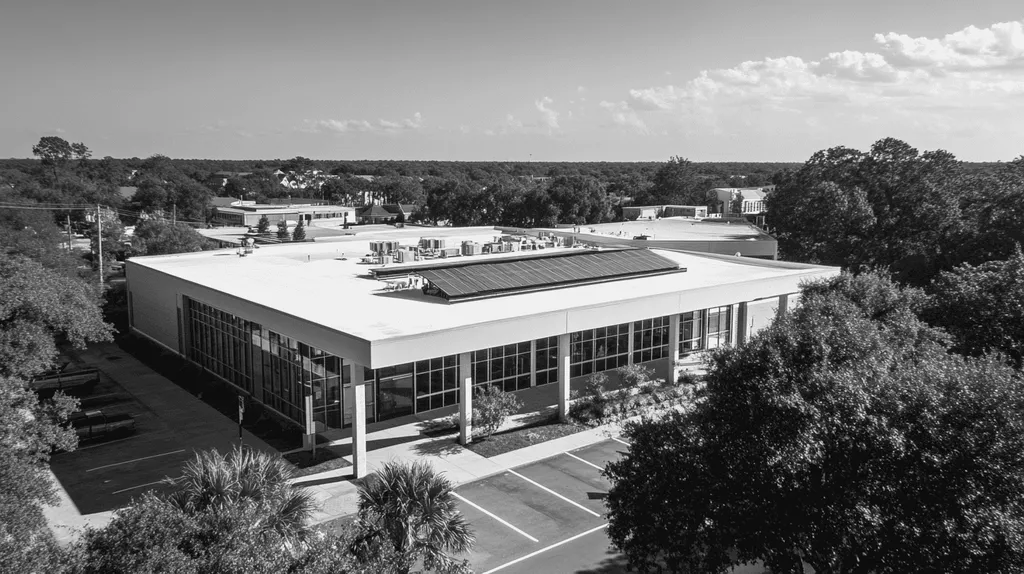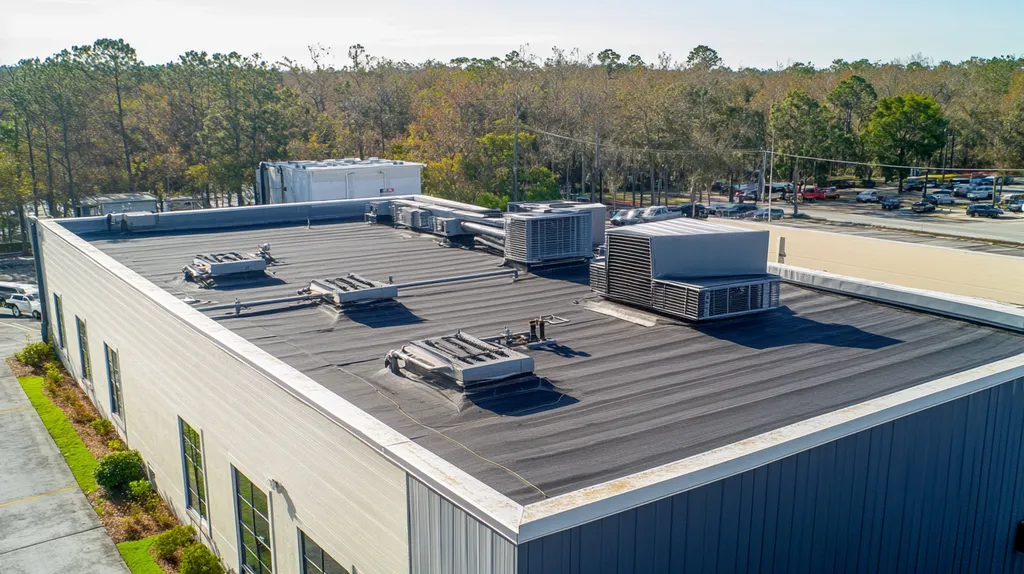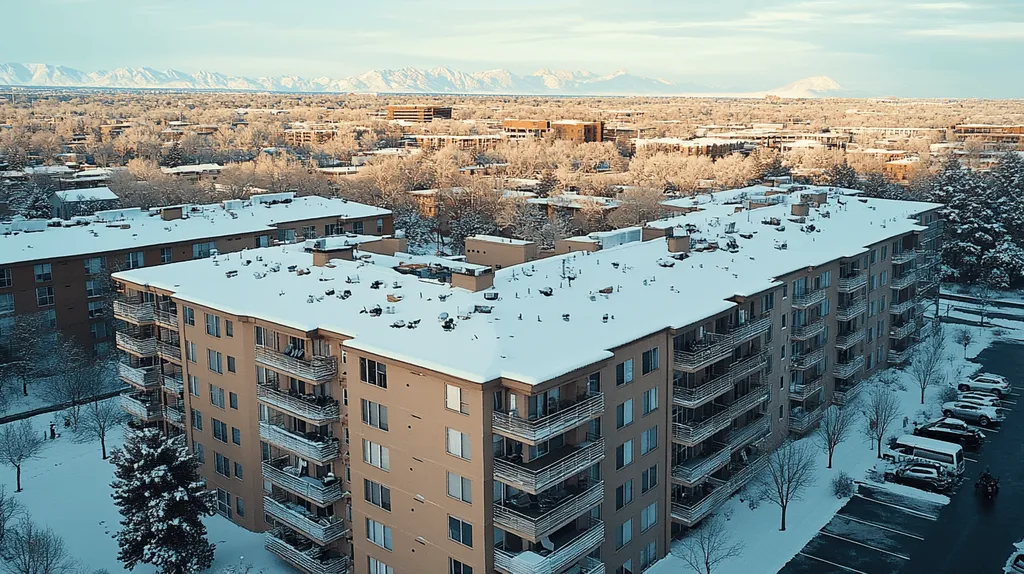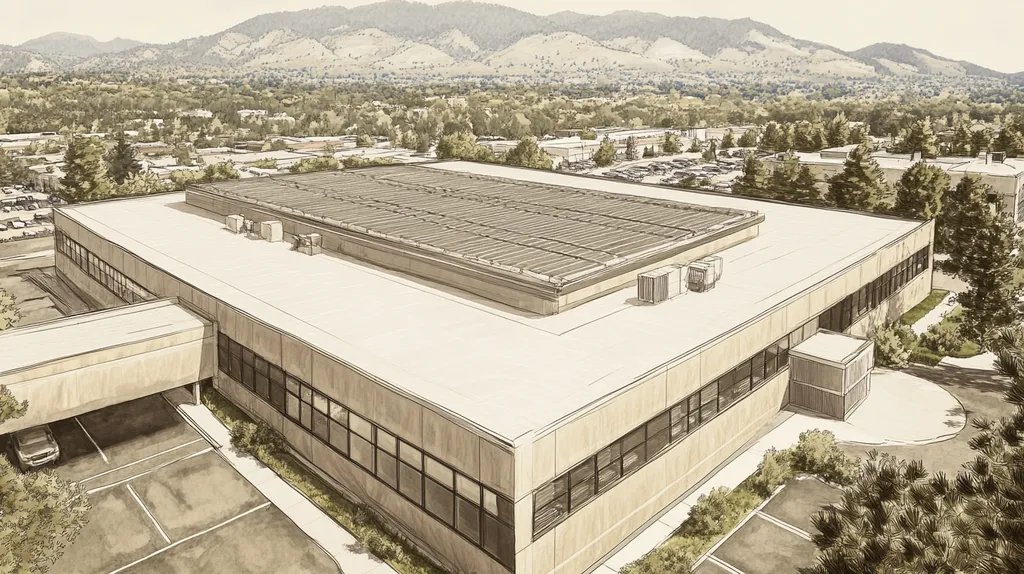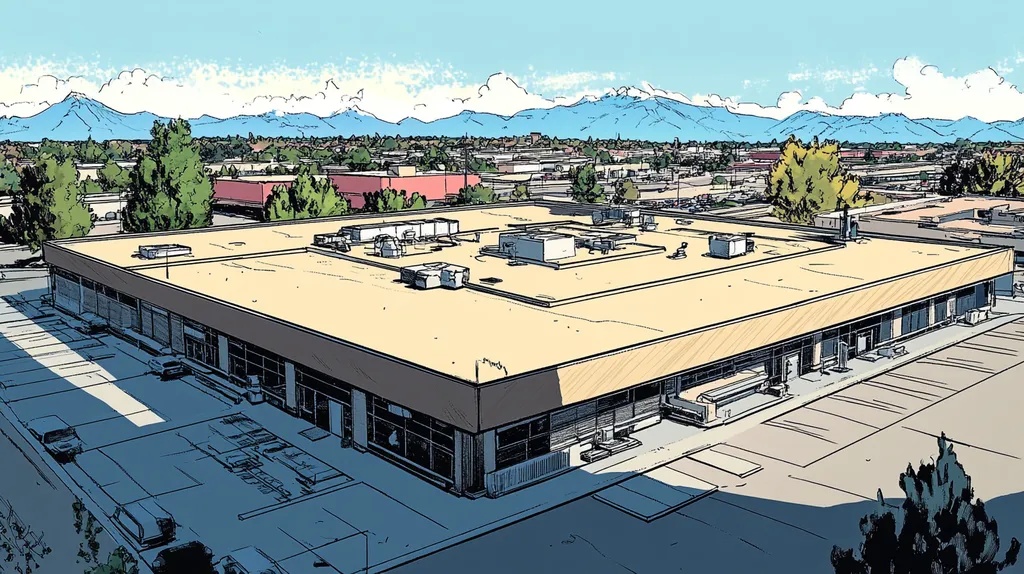Every year, commercial property owners waste millions of dollars replacing roofs years before necessary, largely due to widespread misconceptions about roof lifespans. Industry studies show that up to 85% of roofs are replaced prematurely due to inadequate maintenance and misunderstandings about material durability.
From believing all roofing materials last the same length of time to underestimating the impact of local weather conditions, these misconceptions can severely impact building operations and bottom lines.
This comprehensive guide examines the truth behind common roofing lifespan myths and provides property owners with practical strategies to maximize their roofing investments through informed decision-making and proper maintenance.
SECTION 1: THE BASICS EXPLAINED
Understanding the lifespan of a commercial roof is crucial for property owners and facility managers. A roof acts like a sturdy shield, protecting the building from the elements and preserving your investment. However, there are many misconceptions about how long different roofing materials actually last. These misunderstandings can result in unexpected costs and may jeopardize the structural integrity of your building.
By providing property decision-makers with clear and accurate information, they can make informed choices that have a lasting positive impact on their buildings.
What It Is (In Plain Language)
The lifespan of a commercial roof is the period it can effectively perform in everyday conditions. Depending on the materials and environment, most roofs last between 15 and 50 years. For example, a high-quality TPO membrane might provide solid protection for around 20 years, while built-up roofs can often last more than 30 years.
However, many factors influence this lifespan. Regular maintenance, exposure to weather, and how the roof was installed all play critical roles. These aspects not only determine how long a roof lasts but also affect its overall performance over time.
By grasping these details, property owners can better prepare for the future. Knowledge about expected lifespan enables them to schedule routine inspections and maintenance, ensuring their roofs work effectively for as long as possible. Being well-informed can translate into substantial savings when it comes time to replace the roof.
Why It Matters (To Your Building)
The lifespan of a roof is closely tied to the health of your building and your maintenance budget. As a roof approaches the end of its expected life, problems like leaks, structural damage, or increased energy costs may arise. For businesses, these challenges can disrupt daily operations and lead to considerable financial setbacks.
Knowing about roof lifespan also aids in long-term planning. Well-informed property owners can better allocate resources for future renovations, prioritizing upgrades that boost energy efficiency and enhance property value. For instance, opting for a roof with a longer lifespan reduces the frequency of expensive repairs.
Moreover, longer-lasting roofs often align with sustainable practices. They can minimize waste by utilizing recyclable materials or by requiring less energy during their production, contributing to an eco-friendlier approach.
In summary, a strategic focus on roofing lifespan not only improves financial outcomes but also enhances the building’s overall resilience and sustainability.
How It Works
A number of factors determine a roof’s performance throughout its lifespan. First, selecting the right materials is vital. Different materials like metal, TPO, and EPDM come with their own expected lifespans and maintenance needs. Choosing the right material tailored to the local climate can greatly improve durability.
The quality of installation is also essential. An inadequately installed roof may fail long before its intended lifespan, no matter how good the material is. Hiring skilled contractors with an excellent reputation ensures the roof is put in place correctly and retains its integrity over time.
Environmental factors should not be ignored. Weather conditions—like extreme heat, freezing temperatures, and strong winds—can place significant stress on roofing materials. Regular inspections help identify wear and tear that could jeopardize the roof’s longevity.
Lastly, routine maintenance is key. Simple actions such as clearing gutters and checking for signs of damage can significantly extend a roof’s lifespan. Keeping up with these maintenance tasks not only helps avoid costly repairs but also provides peace of mind that the building remains well protected.
SECTION 2: PRACTICAL APPLICATIONS
The lifespan of a commercial roof isn’t just a statistic; it significantly influences a property’s value and ongoing expenses. Many property owners mistakenly believe their roofs will stand strong for a predetermined number of years without maintenance. Alarmingly, nearly 30% of commercial roofs fail prematurely, mainly due to insufficient upkeep and improper installation. Having a solid grasp of practical applications can empower property managers to make better decisions, ultimately extending their roofs’ lives.
Common Uses & Examples
Commercial roofs do much more than shield buildings from weather. They often house critical elements like HVAC systems, skylights, and even green roofs. These uses play a pivotal role in selecting the right materials, which directly impacts durability.
Single-ply roofing systems are favored for their lightweight and flexible nature. However, if installed incorrectly over an existing roof, they can trap moisture, drastically shortening their life. This highlights the importance of understanding how the roof will be used when choosing materials.
Each roofing type brings its own set of pros and cons. For example, while a flat roof allows for convenient rooftop installations, it can also lead to water pooling if drainage isn’t managed properly.
By selecting the right roofing system for its intended use, property owners can maximize both functionality and lifespan.
When You Need It Most
Often overlooked until a crisis arises, proactive roof maintenance is vital for longevity. Routine seasonal inspections can detect minor leaks before they turn into major headaches. Many property managers underestimate how neglecting maintenance can undermine a roof’s performance.
Take the aftermath of a fierce storm: roofs lacking proper upkeep face damage that could have been easily avoided. Swift inspections after severe weather can help property owners dodge expensive repairs.
Implementing a maintenance schedule ensures roofs perform at their best, especially during extreme weather conditions. This approach can also highlight the ideal times for necessary upgrades or replacements.
Without regular attention, roofs can deteriorate, impacting other systems in the building and potentially leading to larger financial setbacks.
Interactions With Other Systems
The relationship between a roof and other building systems is often underestimated. Roofs support HVAC units, influence energy efficiency, and affect insulation effectiveness. A failing roof can result in skyrocketing energy bills and compromised indoor air quality, straining operational budgets.
For instance, a leaking roof can cause insulation to absorb water, rendering it ineffective. Property managers must understand how roof issues can cascade through a building’s framework.
Collaboration between roofing contractors and HVAC specialists can optimize energy performance. Integrating roofing systems with other building components is crucial for maximizing lifespan and functionality.
Recognizing these interactions enables facility managers to make informed decisions that not only reduce costs but also enhance the overall performance of the building.
SECTION 3: KEY TERMINOLOGY DECODED
Grasping roofing terminology is not just helpful; it’s essential for commercial property owners and facility managers. Misunderstanding key terms can lead to costly mistakes that may significantly diminish a roof’s lifespan. For instance, many wrongly believe that their roofs are guaranteed to last 20 years. In reality, aspects like material quality and maintenance practices can dramatically influence that duration. This section will break down important terms, clarify industry jargon, and simplify measurement units related to commercial roofs.
Essential Terms Explained
When discussing roofing, “lifespan” typically describes the duration a roof will effectively perform before requiring major repairs or replacement. A common misconception is that this term implies a warranty. In truth, a roof’s lifespan depends on materials, climate conditions, and maintenance efforts.
The term “R-value” is crucial as it indicates a roof’s insulation efficiency. A higher R-value reflects better insulation, which can lead to substantial savings on energy bills. Unfortunately, many property owners overlook this when assessing their roofing options.
You’ll likely encounter terms like “TPO” and “EPDM” frequently. TPO, or Thermoplastic Olefin, is celebrated for its energy efficiency in single-ply roofing membranes. In contrast, EPDM, or Ethylene Propylene Diene Monomer, is a strong rubber roofing choice. Each material meets different needs and project specifications.
Lastly, “drainage” refers to how effectively a roof manages water. Inadequate drainage can severely shorten a roof’s lifespan, creating leaks and structural damage. Assuming that every roof has sufficient drainage can be a major oversight.
Industry Jargon Translated
Roofing jargon can be bewildering, especially for those outside the industry. “Flashing” is one of those terms, referring to the materials used to prevent water from leaking at roof seams and joints. Recognizing its importance can help property owners appreciate the necessity of proper installation during repairs.
The term “roof deck” frequently surfaces in conversations. It represents the structural underlayer supporting the entire roofing system. A properly built deck is crucial for a roof’s durability, yet many property owners may miss this element during inspections.
Finally, the term “conversion” surfaces when talking about roof upgrades. It involves changing an existing roof type into a new one without a complete teardown. While conversion can be a cost-saving option, it’s important to understand its long-term implications.
Measurement & Units Simplified
Getting a grip on roofing measurements is vital for making smart decisions. Roof sizes are typically stated in square feet, indicating the total area that needs coverage. A common mistake is assuming this measurement includes sloped areas, which can skew material requirements.
The term “square” is essential in roofing, representing an area of 100 square feet. Understanding this unit is crucial since material costs are often calculated per square. Incorrect assumptions about roof size can lead to unexpected expenses.
“Ply” is another significant term, indicating the number of layers in a roofing system. For example, a single-ply membrane is a common choice for commercial roofs, whereas multi-ply systems offer extra durability. However, many property owners mistakenly believe more plies always equate to better performance.
Finally, “pitch” describes the slope of a roof and is often misjudged as irrelevant, especially for flat roofs. However, pitch affects drainage and overall lifespan. Knowing the pitch helps property owners select the most suitable roofing system for their specific building needs.
SECTION 4: DECISION FACTORS
Making informed decisions about commercial roofing is crucial for property owners. The choices made now can deeply affect operational costs, roof performance, and durability—ultimately impacting the roof’s longevity. Understanding which factors to prioritize can help avoid unforeseen expenses and extend the life of a building’s protective layer.
Cost Considerations
The price of a commercial roof is more than just its initial cost. It’s a common misconception that lower upfront costs equate to overall savings. While opting for a cheaper roof material might appear budget-friendly, it can lead to higher expenses from repairs and replacements over time.
For instance, a single-ply membrane may look like a steal initially, but it frequently demands more maintenance. Those costs can accumulate quickly, negating any short-term financial advantages. Understanding the total cost of ownership is vital for making sound financial choices.
Investing in a premium roofing system may require a larger upfront investment, but it can significantly reduce lifetime expenses. A resilient roof will handle weather challenges more effectively, minimizing repair needs and protecting cash flow over time.
Property managers should evaluate lifecycle costs, considering material, labor, and anticipated maintenance expenses. A well-rounded investment strategy can maximize returns and ensure lasting peace of mind throughout the roof’s lifespan.
Performance Trade-offs
Performance is a critical factor in differentiating roofing systems. Grasping how specific materials behave under various conditions is essential to making a smart investment. For example, some materials may perform admirably under extreme temperatures but falter in flexibility, which could lead to cracks and leaks.
Low-slope roofs often thrive with materials like TPO or EPDM, known for their UV resistance and energy efficiency. However, their real-world performance depends heavily on regional climatic conditions—ignoring this can result in expensive failures.
Furthermore, property owners should be mindful of how performance influences warranties. Higher-performing roofs often come with superior warranties that cover significant damage from environmental stresses, while budget options might offer minimal protection, impacting reliability and long-term functionality.
Opting for performance rather than just initial cost may seem like a greater expense, but it ultimately safeguards the property’s integrity over time. Understanding performance specifications allows property owners to align selections with their building’s unique needs.
Lifespan & Durability Factors
The lifespan and durability of a roofing system are interconnected and should heavily influence decision-making. Certain roofing materials are specifically engineered to endure extreme weather, which directly affects longevity. For example, built-up roofs (BUR) are known for their puncture resistance and UV protection, offering a longer service life when maintained properly.
Installation quality also plays a pivotal role in durability. A poorly installed roof, regardless of its material, is likely to face issues that degrade its lifespan. Hiring experienced professionals can significantly influence whether a roof lasts 15 years or just 5 years.
Environmental conditions greatly affect a roof’s longevity as well. Buildings located in regions with harsh temperatures or frequent storms should utilize more durable materials to ensure longevity. Failing to account for local climate conditions can lead to unexpected replacements and costly repairs.
Additionally, proactive maintenance is essential for maximizing any roofing system’s lifespan. Regular inspections and timely repairs can transform minor issues into significant problems. By understanding these factors, property owners can select roofs designed to endure and effectively protect their investments.
SECTION 5: COMMON CHALLENGES
Property owners and facility managers must be aware of the challenges that can arise with commercial roofing. Ignoring regular maintenance or failing to notice early warning signs can lead to unnecessary expenditures and interrupts daily operations. Alarmingly, studies show that up to 80% of roofing failures could be avoided with proactive care. By addressing common challenges head-on, property managers can ensure their roofing systems perform at their best for years to come.
Frequent Problems & Solutions
Commercial roofs often face challenges, including leaks, punctures, and drainage issues. Leaks can be particularly sneaky, often remaining hidden until they cause extensive damage. Conducting regular inspections—ideally twice a year—can help uncover these vulnerabilities before they escalate.
Punctures generally come from foot traffic or falling debris, compromising the roof’s integrity. To mitigate this risk, installing walk pads in high-traffic areas can protect sensitive spots. For effective drainage, regular cleaning of gutters and outlets is vital to prevent water buildup.
Moisture infiltration poses another risk, leading to mold growth and structural damage. Completing moisture surveys can help identify hidden leaks early on. Collaborating with roofing professionals to create a comprehensive action plan can further enhance the long-term health of the roofing system.
In essence, taking timely actions through routine maintenance and inspections can alleviate common roofing problems, safeguarding both the structure and its occupants.
Warning Signs To Watch For
Spotting warning signs early can significantly extend the lifespan of a roof. Property managers should be alert for curling or buckling membranes, as these can indicate aging or thermal stress. These visible indicators often hint at serious underlying issues.
Standing water on flat roofs is another critical concern, signaling potential drainage problems. The longer water sits, the higher the risks of leaks and degradation. After heavy rainfall, property owners should conduct visual inspections to pinpoint pooling areas swiftly.
Rust on metal roofing and excessive granule loss on asphalt shingles also signal deterioration. Addressing these red flags promptly can prevent more extensive repairs in the future. Regular inspections, combined with vigilant observation, enable property owners to act decisively and effectively.
Preventative Approaches
Embracing preventative strategies is vital for maximizing the lifespan of a commercial roof. A robust maintenance plan includes routine inspections to identify potential problems before they evolve into major issues. Best practices suggest at least two inspections a year, ideally before and after severe weather seasons.
Setting up a maintenance fund can facilitate timely repairs, helping mitigate unexpected costs. This proactive approach enables property owners to handle maintenance effectively and avoid reactionary fixes that can strain budgets.
Moreover, training staff and maintenance crews on best practices—including avoiding vulnerable areas and recognizing early warning signs—can contribute significantly to overall roof health. Such educational programs can lead to more successful outcomes.
Ultimately, fostering a culture of prevention not only protects the roof but also enhances the property’s overall value. Owners prioritizing preventative measures will enjoy long-term benefits and savings while maintaining a safe and efficient environment.
SECTION 6: NEXT STEPS & RESOURCES
Grasping the nuances of roof lifespans is essential for property owners and facility managers. Misunderstandings can lead to wasted resources and premature roof replacements. For instance, many people assume a commercial roof will last a guaranteed 20 years, but that only holds true with proper maintenance and care. By addressing these misconceptions, property owners can significantly boost the return on their investment and prolong their roofs’ life.
Questions To Ask Providers
Engaging with roofing providers requires asking the right questions to assess their expertise and commitment to quality. Start by inquiring about the materials they recommend, along with their expected lifespans. Understanding their approaches to maintenance can reveal their long-term vision for your roof, ensuring you’re aligned with their practices.
Don’t forget to ask about warranties and the coverage they provide. A reliable provider should clarify whether the warranty covers materials only or includes workmanship as well. This distinction is critical since it directly influences your future costs and responsibilities.
Seeking references from previous clients can give valuable insights into the provider’s reliability and quality of work. Properties that have had ongoing roof maintenance can share their experiences regarding long-term performance and benefits.
Lastly, always get any commitments in writing. A trustworthy provider should be willing to document the services they offer so you can trust the terms and conditions outlined.
Industry Standards & Guidelines
Familiarizing oneself with industry standards is vital for making informed roofing decisions. Organizations such as the National Roofing Contractors Association (NRCA) provide essential guidelines on the longevity of various roofing materials and best maintenance practices. Utilizing these resources can help differentiate between different roofing systems and their respective expected lifespans.
Additionally, the American Society for Testing and Materials (ASTM) provides standards for roofing materials that can help ensure your roof meets quality benchmarks. Adhering to these guidelines not only supports roof longevity but also enhances overall safety and performance.
It is beneficial to stay updated on regulatory changes and local building codes that affect roofing installations. Being aware of these statutory requirements can prevent costly compliance issues later on.
Engaging with industry publications and attending workshops further enriches one’s understanding. The roofing industry continuously evolves, and keeping up with the latest trends is essential to maximizing the value of your investment.
Further Learning Simplified
For those eager to expand their roofing knowledge, numerous accessible resources are available. Online courses and webinars provide valuable insights into roof maintenance, materials, and industry trends. Websites dedicated to commercial roofing often host free guides and articles to help simplify best practices.
Joining industry associations can open networking doors, allowing property managers to connect with peers and experts. These connections can lead to shared experiences and insights about effective roofing strategies, enhancing overall knowledge.
Subscribing to newsletters from reputable roofing organizations can keep you updated on the latest technologies, innovations, and research affecting roof management and longevity.
Lastly, local building supply retailers frequently host informative sessions about new products and solutions. Engaging with these resources ensures property owners are equipped with the latest knowledge to protect their roofing investments effectively.
The Bottom Line
With nearly $5 billion spent annually on premature commercial roof replacements, understanding roof lifespan factors has never been more critical for property owners.
The misconception that all roofs last their rated lifespan without proper maintenance continues to cost businesses millions in avoidable expenses.
By implementing regular inspections, choosing appropriate materials, and working with qualified contractors, property owners can extend their roof’s functional life by 25-40% beyond manufacturer estimates.
The key lies in shifting from reactive to proactive maintenance, understanding local climate impacts, and making informed decisions about materials and installation methods.
Moving forward, success depends on property owners embracing evidence-based maintenance practices while staying current with evolving industry standards and technologies.
FREQUENTLY ASKED QUESTIONS
Q. What is the lifespan of a commercial roof?
A. The lifespan of a commercial roof varies by materials and environment. Most roofs last between 15 and 50 years. Regular maintenance and the installation quality play key roles, so understanding these factors can help you maximize your roof’s effectiveness.
Q. How does a commercial roof’s lifespan affect property value?
A. The lifespan of a commercial roof impacts the overall value and costs associated with a property. If property owners neglect maintenance, roofs may fail prematurely, leading to costly repairs and reduced property value. Regular care can preserve and even enhance your investment.
Q. What roofing terms should I know for a commercial roof?
A. Important roofing terms include “lifespan,” which refers to how long a roof performs before major repairs are needed. Other terms like “R-value” and “drainage” significantly influence your roof’s effectiveness and energy efficiency, making familiarity with them essential for any property owner.
Q. What factors influence the decision when choosing a commercial roof?
A. Cost and performance are crucial when selecting a roofing system. While lower initial prices may seem appealing, these options can lead to higher long-term expenses due to maintenance needs. Evaluating the total cost of ownership can guide better decisions for your commercial roof.
Q. What common challenges do commercial roofs face?
A. Common challenges for commercial roofs include leaks, punctures, and drainage problems. Regular inspections and maintenance are crucial to spotting these issues early and preventing costly repairs. Proactive care can dramatically extend your roof’s lifespan and protect your building.
Q. What steps should I take after learning about commercial roofs?
A. It’s essential to ask potential roofing providers pertinent questions about their materials, expected lifespans, and warranty coverage. Familiarizing yourself with industry standards and best practices can also guide your decisions on maintenance and upgrades that could extend your roof’s life.
Q. How do I choose the right contractor for my industrial roof?
A. Choosing the right contractor involves reviewing their experience, credentials, and past work. Look for reviews or testimonials from previous clients to gauge reliability and craftsmanship. Ensuring they understand your specific industrial roof needs will help you achieve the best results.

